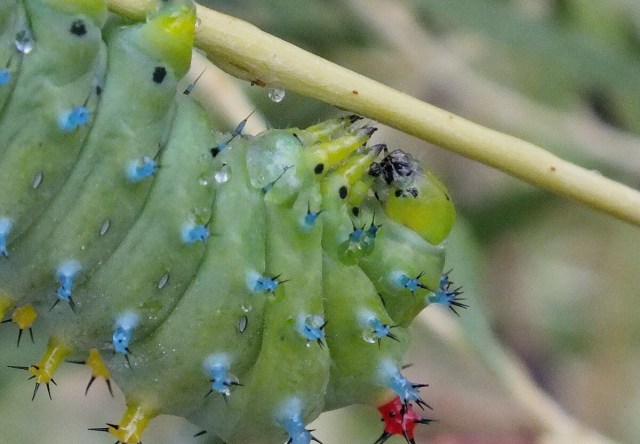Cecropia Moth Caterpillar in Rouge National Urban Park

On a late July afternoon, on his way to a local farmer’s market, Bob made a brief stop at North Reesor Pond in Rouge National Urban Park . His intention was to look for shorebirds, but with none presenting, he began to scour the reeds and bushes for insects. That is when he happened upon this most unusual caterpillar, a Cecropia Moth Larva.
It was a damp day so I had remained at home baking and doing laundry. An excited call from Bob had me green with envy. I knew from his description that he was looking at a Cecropia Moth caterpillar, something that neither of us had ever seen before.
Hasty plans were drawn up. Bob continued to the market to give my Zucchini Loaf time to finish baking before he hastened home to fetch me. I really wanted to see this caterpillar.
We eventually arrived back at Reesor Pond even as a thunderstorm approached from the west. Bob was able to lead me straight to the Willow Bush where he had left the Cecropia Moth larva.
I had left the house hastily, even taking the Zucchini Loaf out of the oven a few minutes early. No thought was given to my attire, so I ended up on sight wearing a skirt and without a hat.
When first hatched, a Cecropia Moth caterpillar is black in appearance owing to distal black spines growing from tuburcules on the body. A newly hatched larva would be very tiny, about the size of a mosquito, whereas the one we had in front of us was about 2.5 inches long.
Many of the first instar larvae would have been snapped up for bird food or eaten by spiders. Black, fuzzy baby caterpillars stand out against the leaves of their host plant and are easy pickings for birds that need to feed their nestlings.
Each larval instar lasts about one week, during which time a caterpillar feeds voraciously. Cecropia Moth larvae increase in size substantially. The skin does not grow to accommodate the bigger size but becomes stretched to the limit. That is when it is time for a caterpillar to shed its skin.
As a Cecropia Moth caterpillar moves from the first instar through to the fifth instar, it becomes yellowish green then bluish green, and the tuburcules change colour to blue, yellow and red.
By the time a Cecropia Moth larva reaches its fifth instar, all of the black hairs or spines will have been lost. This Cecropia Moth caterpillar was likely in its third instar. It would reach maturity a couple of weeks after we observed it.
When a Cecropia Moth larva is ready to pupate, its body will have a distinct blue colour. By then, it will be between 4-4.5 inches long, so this one had a ways to grow yet.
Earlier in the summer, also at Reesor Pond North, Bob and I came across a pair of Cecropia Moths mating. They were found a couple hundred feet from where we found the Cecropia Moth larva.
The process of a male Cecropia Moth fertilizing a female’s eggs takes place over the course of a whole day. Once the Moths find each other, they cling to one another while holding fast on some suitable support, in this case the stalks of some Phragmites.
A female Cecropia Moth will select an appropriate host plant upon which to lay her eggs so that when the eggs hatch, the larvae will have something to eat. The Willow Bushes where Bob found this caterpillar were ideal.
A female Cecropia Moth lays more than 100 eggs then dies shortly thereafter. The eggs hatch between one and two weeks later depending upon the weather.
The circle of life for a Cecropia Moth takes about one year. By late summer, when a caterpillar completes its fifth instar, it is ready to spin a cocoon.
A Cecropia Moth larva will spend several days spinning a tough, brown weather-resistant cocoon like this one that we found at another location in Rouge National Urban Park in early April.
Inside the cocoon, the larva will pupate and prepare to weather the cold winter months. Metamorphosis will transform the Cecropia Moth pupa into the beautiful moth that will emerge in late spring.
Bob and I spent a good 20 minutes or so observing this most beautiful caterpillar for fear we might never see one again.
We were quite taken with the intricacies of its anatomy that our close encounter allowed us to appreciate. The way it used its five pairs of prolegs to walk along the thin willow stalk was endearing.
Prolegs are not really legs at all but actually protrusions from a caterpillar’s abdomen. Still, they are used to aid in locomotion because they are capable of gripping surfaces. The true legs are positioned closer to the caterpillar’s head.
The true legs look more like legs and less like extensions of the abdomen.
A Cecropia Moth larva can efficiently devour any sized leaf with its mandibles. Even as we looked on, this caterpillar stripped one leaf after another off the Willow Bush.
Bob and I were amazed at the beauty of the Cecropia Moth caterpillar. That Mother Nature can provide such intriguing and colourful creatures to delight us is truly awe inspiring.
You May Also Like:
Cecropia Moths mating in Rouge National Urban Park
Tomato Hornworm Moths At Grand Canyon National Park
A Modest Sphinx Moth Caterpillar at Oxtongue Lake
A Flutter of Monarch Butterflies At Toronto Shoreline
Monarch Butterfly Chrysalis At Tommy Thompson Park





























